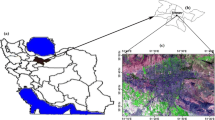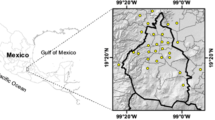Abstract
Nowadays, pollutants continue to be released into the atmosphere in increasing amounts with each passing day. Some of them may turn into more harmful forms by accumulating in different layers of the atmosphere at different times and can be transported to other regions with atmospheric events. Particulate matter (PM) is one of the most important air pollutants in the atmosphere, and it can be released into the atmosphere by natural and anthropogenic processes or can be formed in the atmosphere as a result of chemical reactions. In this study, it was aimed to predict PM10 and PM2.5 components measured in an industrial zone selected by adaptive neuro-fuzzy inference system (ANFIS), support vector regression (SVR), classification and regression trees (CART), random forest (RF), k-nearest neighbor (KNN), and extreme learning machine (ELM) methods. To this end, in the first stage of the study, the dataset consisting of air pollutants and meteorological data was created, the temporal and qualitative evaluation of these data was performed, and the PM (PM10 and PM2.5) components were modeled using the “R” software environment by artificial intelligence methods. The ANFIS model was more successful in predicting the PM10 (R2 = 0.95, RMSE = 5.87, MAE = 4.75) and PM2.5 (R2 = 0.97, RMSE = 3.05, MAE = 2.18) values in comparison with other methods. As a result of the study, it was clearly observed that the ANFIS model could be used in the prediction of air pollutants.











Similar content being viewed by others
Data availability
Pollutant data are freely available from https://sim.csb.gov.tr/STN/STN_Report/StationDataDownloadNew
References
Altman, N. S. (1992). An introduction to kernel and nearest-neighbor nonparametric regression. The American Statistician, 46(3), 175–185.
Bell, M. L., Dominici, F., Ebisu, K., Zeger, S. L., & Samet, J. M. (2007). Spatial and temporal variation in PM2. 5 chemical composition in the United States for health effects studies. Environmental health perspectives, 115(7), 989–995.
Breiman, L., Friedman, J., Stone, C. J., & Olshen, R. A. (1984). Classification and regression trees. CRC press.
Broitman, D., & Portnov, B. A. (2020). Forecasting health effects potentially associated with the relocation of a major air pollution source. Environmental Research, 182, 109088.
Chaulya, S. K., Singh, A. K., Singh, T. B., Mondal, G. C., Singh, S., Singh, S. K., & Singh, R. S. (2020). Modelling for air quality estimation for a planned coal washery to control air pollution. Environmetal Modelling and Assessment, 25, 775–791.
Cihan, M. T. (2019). Prediction of concrete compressive strength and slump by machine learning methods. Advances in Civil Engineering, 2019.
Gazete, R. (2008). Hava Kalitesi Değerlendirme ve Yönetimi Yönetmeliği. Çevre ve Orman Bakanlığı (26898), 06.
Gill, J., Singh, J., Ohunakin, O. S., Adelekan, D. S., Atiba, O. E., Nkiko, M. O., & Atayero, A. A. (2020). Adaptive neuro-fuzzy inference system (ANFIS) approach for the irreversibility analysis of a domestic refrigerator system using LPG/TiO 2 nanolubricant. Energy Reports, 6, 1405–1417.
Goldizen, F. C., Sly, P. D., & Knibbs, L. D. (2016). Respiratory effects of air pollution on children. Pediatric pulmonology, 51(1), 94–108.
Jang, J.-S. (1993). ANFIS: adaptive-network-based fuzzy inference system. IEEE transactions on systems, man, and cybernetics, 23(3), 665–685.
Kumar, S., Mishra, S., & Singh, S. K. (2020). A machine learning-based model to estimate PM2.5 concentration levels in Delhi's atmosphere. Heliyon, 6(11), e05618.
Liaw, A., & Wiener, M. (2002). Classification and regression by randomForest. R news, 2(3), 18–22.
Liu, X., Liang, Y., & Guo, J. (2019). Heavy metal pollution in Nanchang City and its health implication on traffic policemen. Environmental Science and Pollution Research, 26(18), 17885–17890.
Lovrić, M., Pavlović, K., Vuković, M., Grange, S. K., Haberl, M., & Kern, R. (2021). Understanding the true effects of the COVID-19 lockdown on air pollution by means of machine learning. Environmental Pollution, 274, 115900.
Moon, T. K. (1996). The expectation-maximization algorithm. IEEE Signal processing magazine, 13(6), 47–60.
Mutlu, E. A., Comba, I. Y., Cho, T., Engen, P. A., Yazıcı, C., Soberanes, S., & Ghio, A. J. (2018). Inhalational exposure to particulate matter air pollution alters the composition of the gut microbiome. Environmental Pollution, 240, 817–830.
Norbäck, D., Lu, C., Zhang, Y., Li, B., Zhao, Z., Huang, C., & Wang, J. (2019). Sources of indoor particulate matter (PM) and outdoor air pollution in China in relation to asthma, wheeze, rhinitis and eczema among pre-school children: Synergistic effects between antibiotics use and PM10 and second hand smoke. Environment international, 125, 252–260.
Ozcan, H. K., Balkaya, N., Bilgili, E., Demir, G., Ucan, O. N., & Bayat, C. (2009). Modeling of methane distribution in a landfill using genetic algorithms. Environmental engineering science, 26(2), 441–450.
Özkaynak, H., Frey, H. C., Burke, J., & Pinder, R. W. (2009). Analysis of coupled model uncertainties in source-to-dose modeling of human exposures to ambient air pollution: a PM2. 5 case study. Atmospheric environment, 43(9), 1641–1649.
Rai, P. K. (2016). Biodiversity of roadside plants and their response to air pollution in an Indo-Burma hotspot region: Implications for urban ecosystem restoration. Journal of Asia-Pacific Biodiversity, 9(1), 47–55.
Šimić, I., Lovrić, M., Godec, R., Kröll, M., & Bešlić, I. (2020). Applying machine learning methods to better understand, model and estimate mass concentrations of traffic-related pollutants at a typical street canyon. Environmental Pollution, 263, 114587.
Tong, R., Liu, J., Wang, W., & Fang, Y. (2020). Health effects of PM2. 5 emissions from on-road vehicles during weekdays and weekends in Beijing, China. Atmospheric Environment, 223, 117258.
Tsai, C. W., Hsiao, Y. R., Lin, M. L., & Hsu, Y. (2020). Development of a noise-assisted multivariate empirical mode decomposition framework for characterizing PM 2.5 air pollution in Taiwan and its relation to hydro-meteorological factors. Environment International, 139, 105669.
UNION, P. (2008). Directive 2008/50/EC of the European Parliament and of the Council of 21 May 2008 on ambient air quality and cleaner air for Europe. Official Journal of the European Union.
Vapnik, V. (2013). The nature of statistical learning theory: Springer science & business media.
World Health Organization (2006). Air quality guidelines: global update 2005: particulate matter, ozone, nitrogen dioxide, and sulfur dioxide. World Health Organization.
World Health Organization (2019). Regional Plan of Action for the WHO Global Strategy on Health, Environment and Climate Change. World Health Organization. Regional Office for South-East Asia.
Zhang, L., Wilson, J. P., MacDonald, B., Zhang, W., & Yu, T. (2020). The changing PM2.5 dynamics of global megacities based on long-term remotely sensed observations. Environment International, 142, 105862.
Zhu, Y., Liang, Y., & Chen, S. X. (2021). Assessing local emission for air pollution via data experiments. Atmospheric Environment, 252, 118323.
Acknowledgements
The authors are thankful to Istanbul University-Cerrahpasa Graduate Education Institute for support.
Author information
Authors and Affiliations
Contributions
PC, HO, and HKO analyzed and processed the data. PC and HO developed the machine learning models. PC, HO, and HKO wrote the original draft preparation and review. All authors read and approved the final manuscript.
Corresponding author
Ethics declarations
Competing interests
The authors declare no competing interests.
Additional information
Publisher's Note
Springer Nature remains neutral with regard to jurisdictional claims in published maps and institutional affiliations.
Rights and permissions
About this article
Cite this article
Cihan, P., Ozel, H. & Ozcan, H.K. Modeling of atmospheric particulate matters via artificial intelligence methods. Environ Monit Assess 193, 287 (2021). https://doi.org/10.1007/s10661-021-09091-1
Received:
Accepted:
Published:
DOI: https://doi.org/10.1007/s10661-021-09091-1




